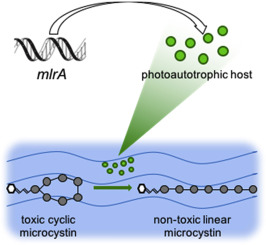Environmental Pollution ( IF 7.6 ) Pub Date : 2018-02-15 , DOI: 10.1016/j.envpol.2018.01.071 Jason Dexter , Dariusz Dziga , Jing Lv , Junqi Zhu , Wojciech Strzalka , Anna Maksylewicz , Magdalena Maroszek , Sylwia Marek , Pengcheng Fu

|
In this report, we establish proof-of-principle demonstrating for the first time genetic engineering of a photoautotrophic microorganism for bioremediation of naturally occurring cyanotoxins. In model cyanobacterium Synechocystis sp. PCC 6803 we have heterologously expressed Sphingopyxis sp. USTB-05 microcystinase (MlrA) bearing a 23 amino acid N-terminus secretion peptide from native Synechocystis sp. PCC 6803 PilA (sll1694). The resultant whole cell biocatalyst displayed about 3 times higher activity against microcystin-LR compared to a native MlrA host (Sphingomonas sp. ACM 3962), normalized for optical density. In addition, MlrA activity was found to be almost entirely located in the cyanobacterial cytosolic fraction, despite the presence of the secretion tag, with crude cellular extracts showing MlrA activity comparable to extracts from MlrA expressing E. coli. Furthermore, despite approximately 9.4-fold higher initial MlrA activity of a whole cell E. coli biocatalyst, utilization of a photoautotrophic chassis resulted in prolonged stability of MlrA activity when cultured under semi-natural conditions (using lake water), with the heterologous MlrA biocatalytic activity of the E. coli culture disappearing after 4 days, while the cyanobacterial host displayed activity (3% of initial activity) after 9 days. In addition, the cyanobacterial cell density was maintained over the duration of this experiment while the cell density of the E. coli culture rapidly declined. Lastly, failure to establish a stable cyanobacterial isolate expressing native MlrA (without the N-terminus tag) via the strong cpcB560 promoter draws attention to the use of peptide tags to positively modulate expression of potentially toxic proteins.
中文翻译:

mlrA在光合自养宿主中的异源表达–工程蓝细菌降解微囊藻毒素
在本报告中,我们建立了原理证明,首次证明了用于自然修复氰毒素的光合自养微生物的基因工程。在模型蓝藻Synechocystis sp。PCC 6803我们已经异源表达了Sphingopyxis sp。USTB-05微囊藻毒素酶(MlrA),带有来自天然Synychocystis sp。的23个氨基酸的N端分泌肽。PCC 6803 PilA(sll1694)。与天然MlrA宿主(鞘氨醇单胞菌)相比,所得的全细胞生物催化剂对微囊藻毒素LR的活性高约3倍。sp。ACM 3962),对光密度进行了标准化。另外,尽管存在分泌标签,发现MlrA活性几乎完全位于蓝细菌胞质部分中,粗细胞提取物显示出与表达MlrA的大肠杆菌提取物相当的MlrA活性。此外,尽管全细胞大肠杆菌生物催化剂的初始MlrA活性提高了约9.4倍,但利用异养MlrA生物催化在半自然条件下(使用湖水)培养时,利用光养养性底盘会延长MlrA活性的稳定性。大肠杆菌的活性4天后,细菌培养消失,而蓝细菌宿主在9天后显示出活性(初始活性的3%)。另外,在该实验过程中保持了蓝细菌的细胞密度,而大肠杆菌培养物的细胞密度迅速下降。最后,未能通过强大的cpcB560启动子建立表达天然MlrA(无N端标签)的稳定蓝细菌分离株,引起了人们对使用肽标签正向调节潜在毒性蛋白表达的关注。











































 京公网安备 11010802027423号
京公网安备 11010802027423号